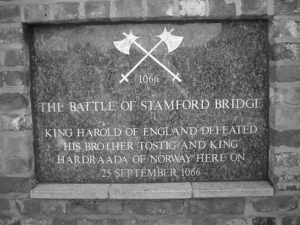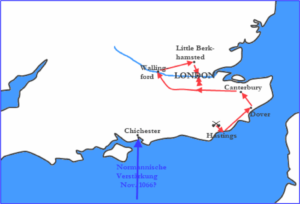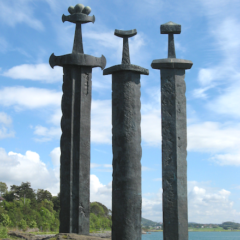The year 1066 was the year of three major battles for the Anglo-Saxons and saw the deaths of three important rulers of the Middle Ages. It was also an important turning point for the political powers of England, the Anglo-Saxon Southern Kingdom and the Danish Northern Kingdom.
Eduard the confessor died childless on 5th January 1066 after a long reign. He was a ruler thanks to the tricky Earl Godwin Wulfnothson and failed to perform the most important duties of a ruler: to govern properly and to father a successor to the throne. Instead, he was the sponsor and founder of the Abbey-Church of St. Peter to Westminster, later known as Westminster Abbey, and distributed crown treasure to the poor. He was later canonized for his good deeds. Already by the 6th January, 1066 the Witan had his wish realised and had Harold Godwinson crowned King of the Anglo-Saxon being the logical consequence of his father’s machinations.
This, in turn, did not suit that warlike warrior on the other side of the English Channel at all, namely Duke William II of Normandy (french: Guillaume le Conquérant), later to be called „the Conqueror“. William believed that due to his relationship with Emma of Normandy (his great- great aunt), he had a dynastic claim to the English throne. Harold Godwinson, on the other hand, lacked any dynastic right to the kingship. William was so angry about Harold’s enthronement that he planned nothing less than an invasion of England over the English Channel. After long preparations, together with his vassals, and after a gruelling wait for better weather, William’s invasion fleet of more than 900 ships crossed the English Channel and landed on 28th Sept. 1066 near and east of Pevensey – the Norman conquest had begun.
But just ten days earlier, King Harald III of Norway, called „Hardrade„, had intervened in the whole event by attacking with a fleet of about 300 ships and probably about 6000 men. He had crossed the North Sea to sustain his claim to the throne. Inspired and led by the exiled brother of King Harold of England, Tostig Godwinson, he wanted to take York and conquer England from the north. On 19th Sept. 1066, he sailed up the Ouse and in a southern suburb of York, Fulford Gate. There he met an army of the Earls Morcar of Northumbria and Edwin of Mercia on 20th Sept. A terrible battle quickly broke out in the swampy area and together with the superior Norwegians, they won the battle decisively.
In the meantime, King Harold II marched his army in four days from the south of England to Tadcaster, to the southwest of York. On the 25th September 1066, he surprised the Norwegian army at Stamford Bridge E of York and was victorious after a violent battle on the hill east of the Ouse (today: Viking Road/Viking Close). The old warrior Harald III of Norway and Earl Tostig Godwinson both lost their lives.

Stamford Bridge Battle Memorial (Photo: Urs Pape)
William the Conqueror’s landing on 28th September 1066, initially met with no resistance from the Anglo-Saxons. He first had to reunite and reorganize his troops, who had landed at different places between Pevensey and Hastings (the coastline being very different in medieval days). William immediately sent out small squads of horsemen to provide food for man and beast, gather news (if necessary by torture) and harass the local villagers. In the early morning of 14th October, he set off with his troops for a battle with his Anglo-Saxon adversaries at Senlac Hill that day. The battle near Hastings (and not ‚of Hastings‘) took the whole day and was won by William the Conqueror just before nightfall only because the Anglo-Saxons had made a serious tactical/disciplinary mistake. In addition to several thousand dead, the last Anglo-Saxon king, King Harold II, (Godwinson) also lost his life on the battlefield of Senlac Hill in todays Battle.
England was however far from being conquered after this victory. Duke William II. was not crowned „Rex Normannorum et Anglorum“ until Christmas 1066. He did not immediately adopt the role of a conqueror, however, as for the time being he did not dare to ride to London but undertook an awkward „walk around London“.

The „Walk around London“ 1066 Graphic: Urs Pape
It finally took until summer of 1070 till his reign over England was finally established and William the Conqueror was crowned „Rex Normannorum et Anglorum“ as William I.
